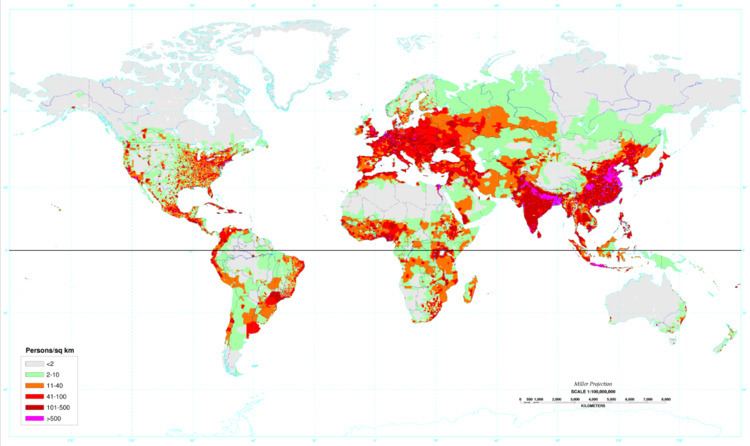 | ||
Population density (in agriculture: standing stock and standing crop) is a measurement of population per unit area or unit volume; it is a quantity of type number density. It is frequently applied to living organisms, and most of the time to humans. It is a key geographical term.
Contents
Biological population densities
Population density is population divided by total land area or water volume, as appropriate.
Low densities may cause an extinction vortex and lead to further reduced fertility. This is called the Allee effect after the scientist who identified it. Examples of the causes in low population densities include:
Human population density
For humans, population density is the number of people per unit of area, usually quoted per square kilometer or square mile (which may include or exclude, for example, areas of water or glaciers). Commonly this may be calculated for a county, city, country, another territory, or the entire world.
The world's population is around 7,000,000,000 and Earth's total area (including land and water) is 510,000,000 square kilometers (197,000,000 sq. mi.). Therefore, the worldwide human population density is around 7,000,000,000 ÷ 510,000,000 = 13.7 per km2 (35 per sq. mi). If only the Earth's land area of 150,000,000 km2 (58,000,000 sq. mi.) is taken into account, then human population density increases to 47 per km2 (120 per sq. mile). This includes all continental and island land area, including Antarctica. If Antarctica is also excluded, then population density rises to over 50 people per km2 (over 130 per sq. mile). However, over half of the Earth's land mass consists of areas inhospitable to human habitation, such as deserts and high mountains, and population tends to cluster around seaports and fresh-water sources. Thus, this number by itself does not give any helpful measurement of human population density.
Several of the most densely populated territories in the world are city-states, microstates, and dependencies. These territories have a relatively small area and a high urbanization level, with an economically specialized city population drawing also on rural resources outside the area, illustrating the difference between high population density and overpopulation.
Cities with high population densities are, by some, considered to be overpopulated, though this will depend on factors like quality of housing and infrastructure and access to resources. Most of the most densely populated cities are in Southeast Asia, though Cairo and Lagos in Africa also fall into this category.
City population and especially area are, however, heavily dependent on the definition of "urban area" used: densities are almost invariably higher for the central city area than when suburban settlements and the intervening rural areas are included, as in the areas of agglomeration or metropolitan area, the latter sometimes including neighboring cities. For instance, Milwaukee has a greater population density when just the inner city is measured, and the surrounding suburbs excluded.
In comparison, based on a world population of seven billion, the world's inhabitants, as a loose crowd taking up ten square feet (one square metre) per person (Jacobs Method), would occupy a space a little larger than Delaware's land area.
Other methods of measurement
Although arithmetic density is the most common way of measuring population density, several other methods have been developed to provide a more accurate measure of population density over a specific area.
